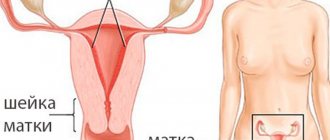Causes of bleeding in early pregnancy
Ectopic pregnancy
At first it is no different from the real thing (presence of toxicosis, tests, absence of menstruation). Bleeding occurs no later than one and a half months of pregnancy, although discharge can be present from the first day.
When a tube ruptures, pregnancy passes into the abdominal cavity, severe pain appears in the lower abdomen (“acute abdomen”), radiating to the rectum, nausea, vomiting, hypotension, and weakness. It is not possible to save the fetus; emergency surgery is required.
Bleeding in early pregnancy due to vascular damage
Damage to the vessels of the uterus when the fertilized egg attaches to the wall - implantation bleeding. Refers to very early bleeding - it occurs approximately a week after conception before the start of the expected monthly cycle.
The egg can damage the smallest capillaries - hence the bleeding. Often does not require intervention, but sometimes is a consequence of a lack of progesterone or implantation of a non-viable cell.
Threatened miscarriage and miscarriage
Occurs with injuries of various kinds, the use of certain drugs, infections of the genitourinary system and abnormal development of the fetus.
If there is a threat of interruption, in addition to spotting, pain is noted that occurs like contractions. Localization of pain is in the lower abdomen.
When abortion begins, clots and tissue elements are visible in the discharged masses, although severe bleeding may be absent. The cervix is not completely closed, and there is a risk of infection. It is possible to continue the pregnancy.
Miscarriage
During a miscarriage (abortion in progress), the embryo dies and leaves the uterine cavity. There is a complete spontaneous abortion, when the fertilized egg completely leaves the uterus. The cervix is completely closed, the uterus is empty.
In the vaginal discharge, a small bubble is visible, divided into parts. Diagnostic curettage is recommended.
With an incomplete abortion, the fertilized egg cannot leave the uterine cavity on its own. Emergency curettage and replacement of blood loss are indicated.
In vitro (artificial) fertilization
With IVF, bleeding in the early stages of pregnancy can begin due to excessive intake of hormones, trauma to the genital organs during egg retrieval, rejection of the fetus by the immune system, prolonged use of the IUD without a change, diabetes, heart, liver, and kidney diseases.
Bleeding in early pregnancy due to increased androgen levels
This pathology is based on a hormonal development mechanism - in the absence of proper treatment, pregnancy is terminated. Sometimes pregnancy is a provoking factor for hyperandrogenism.
The risk group includes women with obesity, polycystic ovary syndrome, increased body hair growth, and acne.
Decidual bleeding in early pregnancy
Changes in hormonal levels cause pseudomenstruation, which can last until the fourth month of pregnancy. Compared to regular periods, these are more scanty. They are not considered a pathology and do not require therapy.
"Frozen" pregnancy
The blood flows either asymptomatically or with nagging pain in the lower abdomen. Often a frozen pregnancy is manifested by signs of intoxication - chills, weakness, increased body temperature.
There is also a disappearance of symptoms of toxicosis, a decrease in basal temperature, and the breasts stop growing and hurting.
Hydatidiform mole
Proliferation of placental villi in the form of vesicles. This is not pregnancy, but a benign formation that occurs due to a violation of the fertilization process: the egg will contain two sets of paternal chromosomes and none of the maternal ones.
This will lead to active growth of chorionic villi, accompanied by distorted symptoms of pregnancy - severe early toxicosis, excessive enlargement of the uterus, high levels of chorionic hormone, inability to determine the presence of a fetus in the uterine cavity. Diagnostic curettage is indicated.
Mechanical damage to the cervix or vagina
It is manifested by the appearance of blood after sexual intercourse due to insufficient natural lubrication and the presence of cervical erosion. The discharge is scarlet in color without mucus or clots. No treatment required.
Gynecological diseases
Bleeding in the early stages of pregnancy can be caused by uterine fibroids, adenomyosis, erosion and cancer of the cervix, polyps of the cervical canal, and varicose veins of the vagina.
Bleeding during pregnancy not from the uterine cavity
These include: nosebleeds, intestinal bleeding, and bleeding from the gums. They arise due to fragility and increased permeability of capillaries, hypovitaminosis, and decreased function of the coagulation system.
Contraindications, precautions, side effects
The medication does not pose any danger directly to the fetus in both early and late stages of pregnancy. Adverse consequences can only occur in the expectant mother. To avoid side effects, Duphaston is not prescribed for:
- severe impairment of liver and kidney function in the stage of decompensation;
- the presence of individual hypersensitivity to the components included in the drug;
- erythrocytosis;
- chronic headaches;
- high sensitivity of the mammary glands;
- bleeding tendency;
- peripheral edema.
Among the adverse events, Duphaston causes:
- diffuse massive bleeding from the vessels of the uterus;
- uterine hypotension;
- weakness of labor;
- allergic reactions (usually urticaria);
- swelling of the lower extremities;
- pain in the chest in the projection of the heart;
- severe headaches (cluster or migraine type);
- disorders of the gastrointestinal tract (constipation);
- hemolytic anemia.
You should take the drug with caution if you have a history of uterine surgery or cancer. This is due to the fact that Duphaston can cause bleeding
First aid
For any bleeding in the first half of pregnancy, you should consult a doctor for proper diagnosis and treatment. Before the ambulance arrives, place the patient on a flat surface with her legs elevated.
Place an ice pack or cold compress on your stomach.
Drink plenty of juice – compote, tea, fruit juice.
Sedatives for relieving anxiety and tension - Motherwort, Valerian.
Antispasmodics – Papaverine in suppositories, No-shpa in tablets.
5%). It’s strange that the doctor didn’t prescribe me any hemostatic drugs. She didn't prescribe anything at all. But I had just registered before this and had tests and smears - everything was normal. According to ultrasound, there are no detachments or hematomas, a normally developing fetus. They did it just before the bleeding, and they also looked very sloppy. My doctor suggested that the examination was bleeding. I read that there is a hemostatic drug TRANEXAM, which is said to be completely harmless for pregnancy, but slow-acting. I think I should take some kind of hemostatic, because normally there shouldn’t be any streaks of blood in the discharge. Girls, tell me, who had bleeding, what medications were you prescribed? What hemostatic agents?
Diagnostic tests
Lack of calcium, or hypocalcemia, is confirmed by blood biochemistry. This test is often done for pregnant women, so diagnosing calcium deficiency is not difficult.
If, based on the test results, the doctor did not focus on the lack of a microelement and did not prescribe maintenance therapy, then the blood counts are normal. However, if the expectant mother notices symptoms of calcium deficiency, she should tell the doctor about this and ask for advice on what to do in such a situation
The doctor can prescribe vitamin and mineral complexes for pregnant women, calcium supplements, and develop a healthy and nutritious menu
However, if the expectant mother notices symptoms of calcium deficiency, she should tell the doctor about this and ask for advice on how to deal with this situation. The doctor can prescribe vitamin and mineral complexes for pregnant women, calcium supplements, and develop a healthy and nutritious menu.
Comments
— They prescribed Tranex, I also often bled in the first trimester
— @jdu_pismo, mmm, okay, I’ll ask!
— @eugenie_smirnova, thank you. And you.
— @stasya.se you can go to the residential complex and ask to take a photo of the card and tests, I did that
— @stasya.se, Have an easy pregnancy and good health!
— @jdu_pismo, I already took the kaugologram, but since I took it for free, the results are in the LCD, and not in my hands
- Yes, I took tranexam. I drank it until the brown discharge went away. But I agree, before that you need to take a caugologram, a blood test that will show the thickness of the blood
— @stasya.se, have an easy pregnancy)
— @stasya.se well, I periodically had blood streaks coming out, after the ultrasound, when they saw a hematoma, I went for an examination, the doctor pulled out my hand, and there were brown marks on the glove. But I didn’t take tranex all the time, namely when I saw blood. Well, plus, with a hematoma, medications alone are not enough; you need complete rest. This is impossible with a small child, so the gynecologist sent me to the hospital.
— @eugenie_smirnova, yes, I’m also against extra pills. Probably, if there are no veins today, then in general I’ll just calm down and wait for the screening, it’s coming soon. I don't want to go for an ultrasound often. Thanks for the advice!
— Tranexam is not a harmless drug, you just don’t need to drink it to be on the safe side, and if you do take it, it’s for a strictly limited number of days. I drank while maintaining it under the supervision of doctors and ultrasound. It’s better to go for an ultrasound, we need to find the reason. Maybe the detachment was not noticed right away, but if everything is fine, then why the extra pills?
— @maryshnurova, it’s good that everything is fine with you! Already 36 weeks. Have an easy last week and birth!
— @natysenka, because they look very bad. rough! And I don't trust them. I might have gone if a doctor I knew had recommended a specific hospital. I know where they will take me if I call an ambulance. I will never go to those doctors again.
— @ruzic, thank you for your wish.
— @katrindzr, wow, it happens too. and when you were told “erosion is bleeding” and you took Tranexam, did you bleed a lot? Or has the bleeding stopped?
When are hemostatic drugs prescribed during pregnancy?
Vaginal bleeding in the early stages of pregnancy is an alarming sign, meaning that the fetus has “problems” that threaten its life. In this situation, it is necessary to urgently seek help from the hospital.
The main sign of open bleeding is detachment of the ovum or placenta in the early stages of gestation.
To avoid negative consequences, doctors prescribe hemostatic drugs in injections, less often in tablets.
An injection of the drug stops the bleeding, but only a doctor can prescribe the drug after examining the pregnant woman and performing an ultrasound scan.
The most popular drugs are: Tranexam, Dicynon and Etamsylate. The latter drug is an analogue of Dicynone.
Based on the situation, the gynecologist prescribes this or that drug, but the main purpose of the pharmaceutical drug is to stop uterine bleeding.
During pregnancy, the issue of blood circulation is very sensitive, because any deviation in homeostasis can cost the life of the fetus and the woman herself.
Doctors select individual treatment when identifying pathological processes.
Increased blood clotting can clog the uterine arteries and disrupt the isthmic-cervical circulation, which leads to acute fetal hypoxia.
Etamsylate is a drug that stops bleeding. It is used:
- to restore the menstrual cycle;
- with irregular periods;
- with uterine bleeding during pregnancy.
Contraindications and possible adverse reactions in pregnant women, overdose
Each calcium supplement has its own restrictions on intake. Contraindications:
- intolerance to components;
- stones and sand in the kidneys;
- excess Ca and vitamin D3 in the body;
- phenylketonuria;
- risk of miscarriage;
- diseases of the digestive tract;
- excessive secretion of the parathyroid glands.
Among the adverse reactions to drugs, skin itching, indigestion, dizziness, and convulsions are most often noted. In this case, the appointment is canceled, a diet or substitute medications are selected.
In case of an overdose, hypercalcemia develops - a dangerous condition for mother and baby. It accelerates the aging of the placenta, accompanied by migraines, irregular heartbeat in women, and increased urination (we recommend reading: reasons for frequent urination during pregnancy). In this case, the fetus develops incorrectly, which is fraught with the occurrence of mental and physical abnormalities. To avoid the negative impact of an overdose on the health of a pregnant woman, activated charcoal and gastric lavage are indicated.
With proper nutrition, sufficient exposure to the sun in the morning and evening, and the absence of disturbances in mineral metabolism and the risk of gestosis, the expectant mother can easily do without calcium tablets. However, when the last trimester falls in the autumn-winter period, health is not ideal, physical activity is reduced, you should consult a doctor about taking additional complexes
You can’t do without them if you have calcium deficiency, which is important to identify and eliminate in time.
Is it possible to use Etamzilat in the early stages of pregnancy?
In obstetric practice, the medicine is prescribed to form a primary blood clot, which entails stopping the bleeding.
In the early stages of gestation, the drug is prescribed after identifying the cause. The entire pathology detection process takes no more than 1 hour.
The hemostatic agent has not undergone clinical trials on pregnant women, so it is difficult to say unequivocally that the drug is harmless. But, despite this fact, no negative consequences from taking Etamzilat have been registered.
In each case, the issue of “life and health of the mother and fetus” or “possible risk of negative consequences” from hemostatic injections is considered.
If the pregnancy is terminated in the early stages and bleeding develops, a hemostatic agent helps.
In the event of a threatened abortion and a miscarriage that has begun, Etamzilat can only stop the bleeding, but not maintain the pregnancy (the cause must be identified).
In the third trimester
In the third trimester, a woman’s hormonal levels and emotional state are quite stable, and if there are no alarming symptoms and the pregnancy is developing normally, then there is no need for sedatives. It is natural for a mother-to-be to feel nervous as the birth approaches.
In the later stages, a woman who is very worried about the upcoming birth can use folk recipes. For example, an infusion of hop cones helps with insomnia (two cones per glass of boiling water, steep for an hour, can be used at night with the addition of honey).
Etamzilat injections during pregnancy: instructions for use
1 ampoule of solution contains the active substance in the form of ethamsylate and excipients: water and sodium derivatives - disulfite, edetate and anhydrous sulfite.
- stimulates the production of platelets, improving their quality properties;
- increases the strength of capillary walls, eliminating their fragility;
- stimulates the formation of mucopolysaccharides;
- restores the disturbed process of blood circulation and blood supply;
- promotes the rapid formation of a primary plug or blood clot.
It is important that, despite the activation of platelet germ and platelet aggregation, the drug does not have a negative effect on the prothrombin index, and therefore is not a cause of thrombosis.
After 10 minutes from the moment of administration of the drug, bleeding stops. The effect of Etamzilat is up to 8 hours. On the first day, preference is given to Etamzilat in injections; further treatment is carried out in tablet form, but this can only be decided by a doctor.
The drug is a prescription drug, available in No. 5 and 10, the average price for 10 ampoules is 130 rubles.
Why is Etamzilat prescribed during pregnancy?
The causes of spotting in the first weeks of pregnancy include:
- hydatidiform mole;
- hormonal disbalance;
- ectopic or ectopic pregnancy;
- endometriosis, polyp or erosive condition of the uterus;
- beginning miscarriage;
- miscarriage;
- infections, including sexually transmitted ones.
In these conditions, uterine bleeding occurs, which without medical help can lead to fatal consequences.
During pregnancy, the drug is intended to stop developing bleeding, and in combination with progesterone-containing drugs - to maintain and prolong pregnancy.
If a pregnant woman experiences disturbances in the circulatory system, the gynecologist may recommend taking Etamzilat tablets:
- with frequent nosebleeds due to hypertension;
- severe thrombocytopenia and thrombocytopathy;
- hypocoagulation.
What are the risks of using an expired product?
A condom is necessary to prevent unwanted pregnancy and protect against infectious diseases. An expired condom does not fulfill its functions, as it easily tears and slips off during sexual intercourse. The use of such a product is fraught with serious consequences.
When using an expired condom, you may:
- Onset of pregnancy. Through poor-quality material, sperm easily penetrate the vagina, where they can meet the egg.
- Infection with sexually transmitted infections. These include syphilis, hepatitis, gonorrhea, chlamydia and many others. These diseases are dangerous and can negatively affect the state of the reproductive system.
- HIV infection. The virus can be transmitted even when using a condom without visible damage. There are enough microcracks that are not visible to the naked eye.
- Development of an allergic reaction. It manifests itself in the form of itching, burning, redness and swelling of the walls of the vagina or penis. Allergies can cause other diseases.
- The occurrence of vaginal dysbiosis. This condition is characterized by changes in the microflora.
Restrictions on indication
The medicinal substance is prohibited for use in the following conditions:
- individual intolerance to the components of the drug;
- thrombosis of small and large vessels;
- thromboembolic disease, especially with a wandering thrombus;
- established Porphyria in the acute stage;
- arterial hypotension;
- hemorrhages due to an excessive dose of anticoagulants.
When using medication injections, you should be prepared for the development of side effects:
- dizziness;
- headache;
- noticeable decrease in blood pressure;
- Heartburn is observed when taking the drug orally.
Dosage and method of administration
When treating with Etamsylate, the dosage is determined by the doctor. Intramuscular administration of the drug is carried out no more than 4 times a day, with a maximum daily dosage of 780 mg.
1 ampoule of the medicinal substance contains 2 ml or 250 mg of active solution.
In emergency situations, doctors administer 1 dose of the drug, and during further treatment, the weight of the pregnant woman is calculated to select an individual dosage. So, for example, per 1 kg of pregnant woman’s weight there is 10 mg of Etamzilate solution.
When administered intravenously, the effectiveness of the drug does not change, but the maximum effect appears faster.
Consultation with a doctor
Emergency stopping of bleeding using Etamzilat solution is carried out only as prescribed by a doctor.
Injections with the drug are often very difficult for women, since the injection itself is painful, and after it a number of side effects are observed, in particular headache and dizziness. Therefore, it is recommended to receive Etamzilat injections while in the hospital.
A pregnant woman should lie down as much as possible and avoid sudden rises and physical exertion. Do not forget that the drug is prescribed to stop bleeding, the cause of which is a violation of the development of gestation.
The drug is also used to correlate uterine bleeding in the absence of pregnancy, for example, with heavy bleeding during menstruation or its prolonged presence.
Very often it is used for surgical interventions, both related to bearing a baby, and for other surgical procedures.
It is possible to superficially apply a cotton pad moistened with an ethamsylate solution to the wound surfaces, for example, for toothache or hemorrhagic diathesis.
Author: Tatyana Valerievna, obstetrician-gynecologist
Especially for the site kakrodit.ru
Do I need treatment?
Treatment may be needed if there is severe blood loss. In such cases, intravenous infusion of blood plasma or red blood cells is performed.
In case of infectious diseases or hormonal imbalances, special etiotropic therapy will be required, which directly affects the cause of bleeding. Serious pathologies, such as ectopic pregnancy, require surgical intervention.
If the cause of vaginal bleeding is not serious, then the doctor may limit himself to general recommendations for maintaining and improving the course of pregnancy.
Mom and I
Every woman should know how to distinguish uterine bleeding from normal menstruation, since uterine bleeding is dangerous to the health and life of a woman. Because of them, you can lose a large amount of blood, and especially during pregnancy, when the uterus is heavily penetrated with blood vessels, especially at this time the placenta is located in it - this is the first source of bleeding. Therefore, delaying the process is fraught with serious consequences, including death. Many women are interested in what medicine to take to stop bleeding and is treatment necessary in such a situation?
Daily iron requirement for a pregnant woman
Additional amounts of iron entering the body of a pregnant woman are consumed in the following processes:
- transformation of uterine tissue;
- hormonal changes;
- organic structure of the fruit;
- placental blood supply;
- accumulation of reserves for hematopoiesis.
The daily requirement for iron is adjusted by a person’s age and gender and averages 20 mg. During pregnancy, the need for iron increases at least twice. Various sources indicate the norm from 27 mg to 1 g per day. The daily calculation of the consumption of microelements has a conditional average value due to the fact that they tend to accumulate in the body.
Even with irregular consumption of foods rich in iron, the body itself determines how much will be stored and how much will be absorbed as proteins and enzymes.
An excess of a microelement occurs in rare cases and is caused by its increased content not in food, but in water. The intake of iron into the body depends not only on the volume of iron-containing foods in the diet, but also on the degree of its absorption. Iron contained in meat products is more easily absorbed than the same trace element in plant foods or synthesized in pharmaceutical supplements. And this fact must be taken into account when planning your diet.
List of nutritional rules that ensure iron absorption:
- Do not wash down food or drink water immediately after eating; the recommended interval is 20 minutes;
- tea, coffee and other drinks, especially those with a diuretic effect, wash microelements from the body, so they should be consumed at intervals of 2 hours;
- vitamins of group C (citrus fruits, cabbage, asparagus), copper, cobalt, zinc (legumes, rice, tomatoes, rye bread), as well as onions and garlic go well with iron-containing foods;
- the consumption of dairy and meat products should be separate.
How to stop heavy bleeding?
What hemostatic drugs can be taken for uterine bleeding? The correct choice will be the one made taking into account the reason that provoked the discharge. But you need to figure out whether you are definitely bleeding and not menstruation.
To do this, you need to remember or look at the calendar, if there is one, when the woman had her previous period, then count whether 21 or more days have passed since that time. Even if the interval is within normal limits, do not forget to take into account the duration of the discharge, what color it was and, of course, the approximate amount.
Every woman knows the characteristics of menstruation, what intensity they occur, character, color and other signs, so she can immediately identify deviations from the norm. Tablets with hemostatic properties are used not only to get rid of discomfort, but also to avoid the development of anemia. Anemia occurs when the volume of blood lost exceeds 80 grams. The bleeding needs to be stopped urgently.
Color also plays a role; during bleeding it is bright red, and during menstruation it is browner. In this case, the blood flows out simply in a stream or large drops.
If the situation has not changed within two hours and a woman changes from 2 to 3 sanitary pads or tampons in two hours, this is a reason to call an ambulance.
Also aspen symptoms of bleeding:
- heavy discharge, the pad is changed more often than once every half hour;
- typical during pregnancy, the release of large blood clots;
- hot flashes;
- clouding of consciousness;
- dizziness;
- heart rate increases.
If these symptoms occur, call a doctor, take a horizontal position and put a cold pack on your stomach. Especially during pregnancy, it is dangerous to get up before the doctor arrives; you must lie in bed.
Every day people encounter different types of bleeding - intestinal, uterine, nasal, pulmonary, hemorrhoidal and gingival.
As a rule, in case of severe internal bleeding after transportation, health workers, sometimes even immediately at the scene of the incident, administer a hemostatic drug intramuscularly to stop the blood.
But often emergency care is required at home, so a bandage, Analgin, Aspirin and hemostatic tablets should be on hand.
Main symptoms
Uterine bleeding in a “special position,” especially at its very beginning, is not a normal phenomenon. In some cases, it may have natural causes and not pose a threat to the woman and the fetus, and sometimes it is a serious pathology that can be fatal not only to the unborn child.
Therefore, a woman should clearly know the symptoms of this condition and, if any of them occur, immediately seek help.
Even minor pinkish or brownish discharge is considered bleeding during pregnancy. They may be light in color, with small streaks of blood.
The discharge may be light or dark brown in color. And they all indicate that something is happening in the reproductive system and you should be wary. Among other things, the discharge may be similar to menstruation both in consistency and quantity. They may contain blood clots. But the worst case scenario is when the blood flows too much that you have to change the pad every hour, or if the discharge is black. In this case, you should immediately call an ambulance.
In addition to blood released from the genital tract, a woman may experience pain in the lower abdomen or lower back. The intensity of the pain can be different - either barely noticeable, like during menstruation, or very strong. Also, in some cases, the temperature may rise.
Treatment of uterine bleeding: drugs
Many women of childbearing age experience uterine bleeding. This symptom occurs against the background of various diseases associated with the genitourinary system.
Therefore, treatment is carried out with the help of special drugs that stop the bleeding. The drugs cope with the problem in a short time. It is also important that the attending physician prescribes the drug and determines the duration of treatment, since spontaneous treatment can aggravate blood loss.
If the source causing the bleeding is not treated, it will occur again and again, the situation will only worsen, and the consequences will become unpredictable.
In gynecology, drugs for bleeding are used such as:
- “Dicynon” has a beneficial effect on the uterine cavity; injections are given or tablets can be taken. Within a few hours after taking the drug, the woman feels relief. For severe discharge, when one pad is changed every half hour, the product is administered intravenously or intramuscularly.
- Calcium chloride - calcium gluconate can also be used in rare cases. Calcium affects blood clotting processes, the drug is administered intravenously, has the effect of a “hot injection”, heat appears throughout the body.
- Aminocaproic acid is considered a synthetic medicine to stop heavy discharge. Prescription and treatment with the drug is carried out only in hospital settings; aminocaproic acid can improve liver function.
- "Kontrikal" is a fibrinolysis inhibitor. It is used intravenously, administered slowly in dilution. With very heavy discharge, it is carried out by drip or micro-stream.
- "Tranexan" is first aid for bleeding. It has a direct effect on coagulation and has a direct effect on plasminogen. Available in the form of intravenous injections and tablets.
- "Ascorutin" - contains ascorbic acid and vitamin P, strengthens blood vessels, fragility and capillary permeability. Suitable for women with heavy periods to prevent bleeding.
- "Tiguna" - used intravenously, there are also analogues in the form of tablets.
- "Vikasol" is one of the most popular. It is a synthetic analogue of vitamin K, in the absence of which the liver does not secrete the necessary proteins directly responsible for the normal process of blood clotting. It is prescribed intramuscularly, there are also tablets.
- “Oxytocin” is a drug that quickly provides relief; it selectively affects the organ cavity. After application, active muscle activity begins - contractions. It is prescribed intravenously, but is also available in tablet form. Also in the postpartum period, methylergometrine and oxytocin are used for bleeding.
What is a hot shot
Hot prick is a non-medical term. This is a common injection of calcium chloride, during which heat begins to spread throughout the patient’s body, because. Due to the dilation of blood vessels, an increased volume of blood passes through the body. The skin of the face, neck and chest may become red. This condition passes very quickly, within a few minutes.
If the drug is injected quickly into a vein, some patients experience nausea, vomiting, dizziness, but the body temperature remains normal.
The most popular injections from the hot series are calcium gluconate, magnesium and calcium chloride.
Gluconate and calcium chloride have similar therapeutic effects, but chloride is more active and causes a greater irritant effect. It is injected strictly into a vein. If the product gets under the skin, tissue necrosis is possible. Calcium gluconate is administered both intramuscularly and intravenously.
Scope of application
The most commonly used is calcium chloride (calcium chloride), which has a positive and beneficial effect on the entire human body. It is able to stop the inflammatory process, increase immunity, and eliminate the negative effects of all kinds of infections.
Injections are given when:
- insufficient amount of calcium in the body;
- skin diseases;
- allergic reactions;
- for problems with the musculoskeletal system;
- intoxication of the human body with fluorine and magnesium salts;
- kidney diseases and hepatitis;
- heavy bleeding.
Surgeons resort to administering calcium chloride injections after surgery.
The drug is administered intravenously. In the hospital, IVs are used for this.
To terminate a pregnancy
A hot injection is used in gynecology to perform an abortion procedure. A hot injection during pregnancy is only permissible when the patient has contraindications to direct surgery or other methods of abortion. The manipulation is carried out under the supervision of a specialist in the gynecology department.
If no symptoms of interruption appear within 2 days, then based on the results of tests and ultrasound, the doctor makes a decision on surgical curettage of the uterine cavity.
If this is not done, a strong infectious process will develop due to the decomposition of dead tissue of the fetus and placenta. Sepsis and death cannot be ruled out.
A hot injection cannot provide a 100% guarantee of terminating an unwanted pregnancy.
What can be used at home?
In a situation where the discharge is small, your period just started, or blood is released after labor (after prior agreement with the treating gynecologist), and also before the ambulance arrives, you can use the following medications:
- "Ditsinon" or "Etamzilat" in the form of tablets 3 times a day, 2 capsules.
- "Tranexan" can be used during pregnancy while you are waiting for an ambulance, in future use only as directed, take 4 times a day, 6 tablets.
- Infusion of Lagochilus intoxicating, one tsp. dilute in 5 tbsp. l. water and drink 3 times a day.
- Infusion of water pepper, 3 times a day, 20 drops.
- If a woman has previously consulted with a doctor who examined her after childbirth, then she can administer oxytocin intramuscularly - one ampoule.











